How to Whiten a Duvet Cover With Ease
You’ve noticed that your once pristine white duvet cover has lost its luster and is now looking a bit dull and dingy. You’ve tried various methods to restore its brightness, but nothing seems to work effectively.
However, there is a simple and efficient way to whiten your duvet cover without much hassle. By using a combination of natural ingredients and a straightforward process, you can bring back the crisp, clean look of your duvet cover.
This method is not only easy to follow but also remarkably effective, providing you with a solution to your whitening woes.
Key Takeaways
- Lemon juice, vinegar, baking soda, borax, and hydrogen peroxide are natural whitening agents that can be used to whiten a duvet cover.
- Soak the duvet cover in a mixture of water and a whitening agent for a few hours or overnight.
- Use baking soda, vinegar, and lemon juice in the washing machine to effectively whiten the duvet cover.
- Air-dry the duvet cover, shake out wrinkles, and use a fabric softener or dryer sheet for a finished look.
Natural Whitening Ingredients
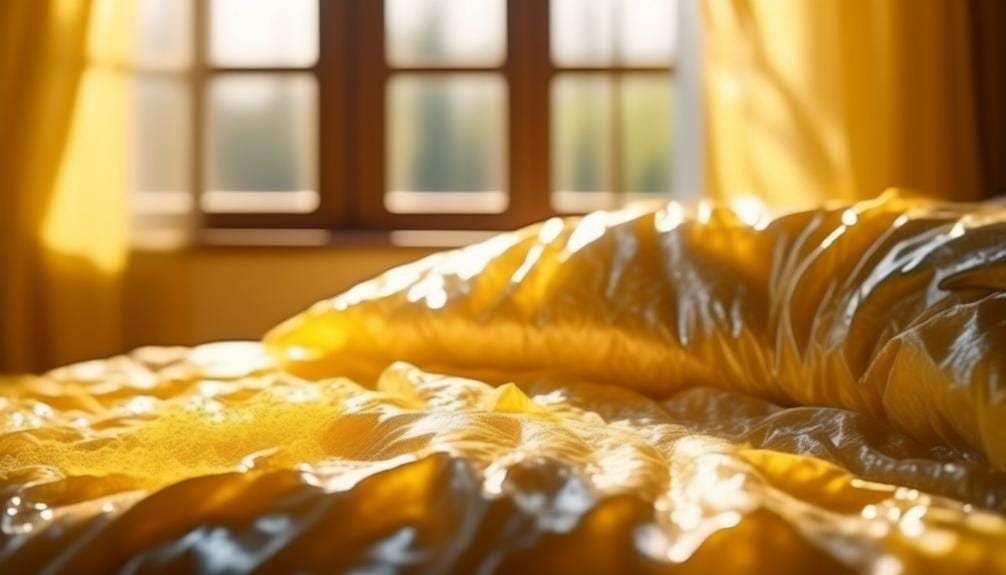
To naturally whiten your duvet cover, you can harness the power of various household ingredients. Lemon, with its natural citric acid, acts as a gentle bleaching agent. You can create a whitening solution by mixing lemon juice with hot water and soaking your duvet cover in it.
Vinegar, known for its natural odor-neutralizing abilities, also serves as a great whitening ingredient. When combined with baking soda, it forms a powerful natural whitening solution.
Baking soda, on its own, not only aids in whitening but also helps to eliminate odors. Similarly, borax, a common household cleaner, can be used to boost the whitening effect in your laundry. You can either add it directly to the washing machine or create a pre-soak solution for your duvet cover.
When it comes to hydrogen peroxide, it’s essential to be cautious, as it shouldn’t be mixed with vinegar or bleach. Instead, consider combining it with baking soda for effective whitening.
Each of these natural ingredients offers an effective and gentle way to whiten your duvet cover, providing an easy and environmentally friendly solution.
Preparing the Duvet Cover
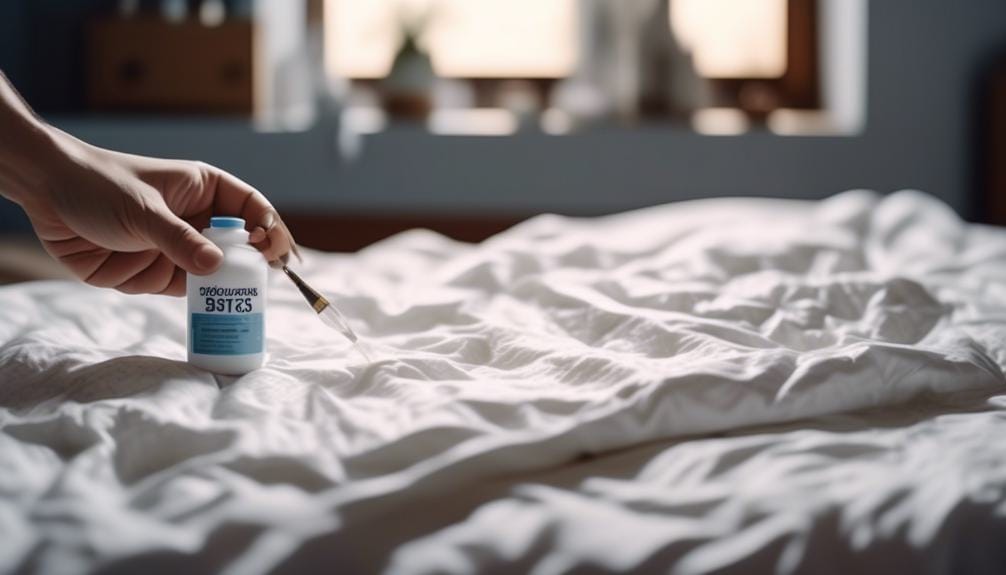
Before washing your duvet cover, consider soaking it in a mixture of water and a whitening agent such as baking soda, vinegar, or lemon juice to help lift stains and discoloration.
Fill a large tub or basin with hot water and add the whitening agent of your choice. For vinegar or lemon juice, a ratio of 1 part whitening agent to 4 parts hot water is ideal. If using baking soda, 1 cup per gallon of hot water should suffice.
Submerge the duvet cover completely and ensure it’s evenly soaked. Gently agitate the cover in the mixture to help the whitening agent penetrate the fabric and target yellow stains.
Allow the duvet cover to soak for a few hours or overnight to maximize the whitening effect. If using vinegar and baking soda, keep them separate during the soaking process to prevent neutralization.
Once the soaking is complete, proceed with a regular wash cycle using a mild detergent. This preparation method will ensure your duvet cover is ready to be effectively whitened during the wash.
Whitening Process
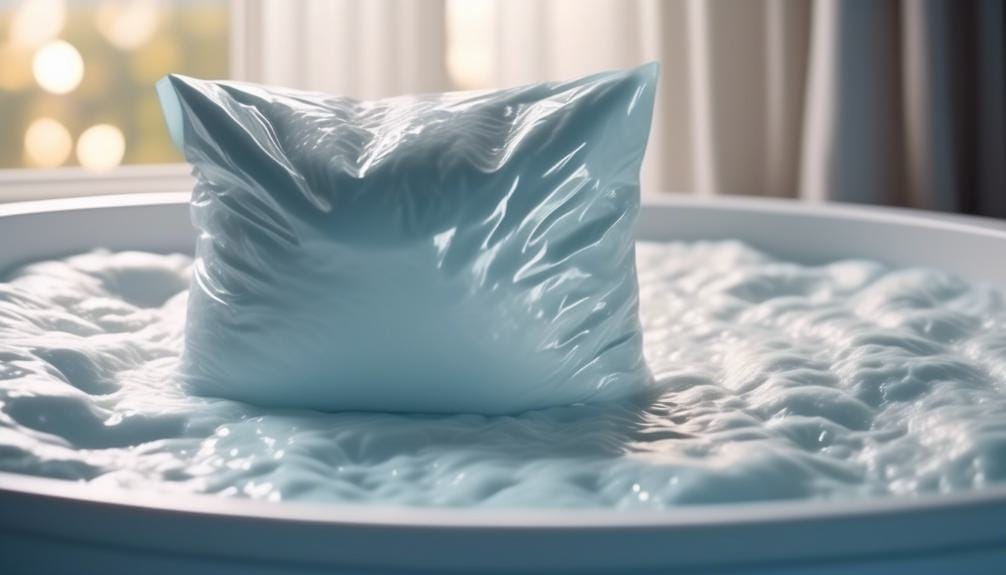
For effective whitening of your duvet cover, consider using baking soda and vinegar separately in the washing process. Here’s how to do it:
- Baking Soda: Add about a half cup of baking soda directly to the washing machine drum along with your regular detergent. The alkaline nature of baking soda helps to break down any residue or build-up that may be causing the duvet cover to appear dull or discolored.
- Vinegar: Pour distilled white vinegar into the fabric softener dispenser. It’s essential not to mix the baking soda and vinegar together, as this can render them less effective. Ensure the vinegar is released later in the cycle through the fabric softener dosing cup. The acidic properties of vinegar act as a natural fabric softener and also help to brighten and whiten the duvet cover.
- Lemon Juice: Consider adding lemon juice to the wash for an extra boost of whitening power. The natural citric acid in lemon juice can help to lift stains and brighten the fabric.
- Hot Water: Use the hottest water temperature that’s safe for the fabric to help activate the cleaning and whitening properties of the baking soda, vinegar, and lemon juice.
Following these steps will help you achieve a noticeably whiter and softer duvet cover with minimal effort.
Drying and Finishing Touches
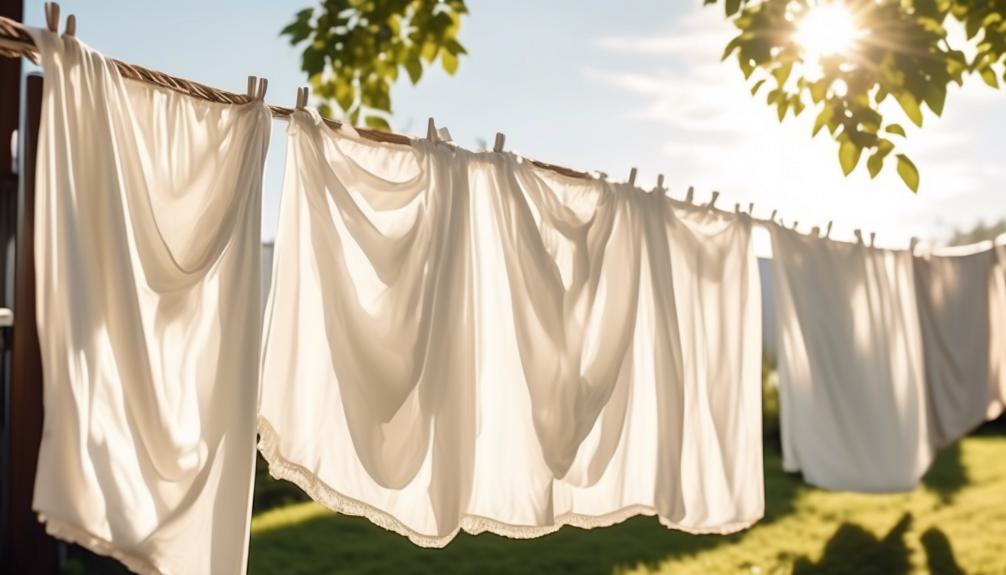
Consider air-drying your duvet cover to eliminate any lingering vinegar smell and give it a fresh finish. After washing the duvet cover with a whitening laundry booster, remove it from the washing machine and shake it out to smooth any wrinkles. Hang it on a clothesline or drying rack, allowing the fresh air to naturally remove any remaining odors.
If you prefer using a dryer, add a fabric softener or dryer sheet to infuse a fresh scent and softness into the duvet cover. Once dry, shake out the cover again to ensure it’s fully dried and fluff it up to give it a finished look. If there are still wrinkles, lightly iron the duvet cover on a low setting to achieve a crisp, wrinkle-free finish.
After drying and smoothing out any wrinkles, your duvet cover will be ready for use. With these drying and finishing touches, your white bedding will look and feel fresh, clean, and inviting.
Maintenance Tips
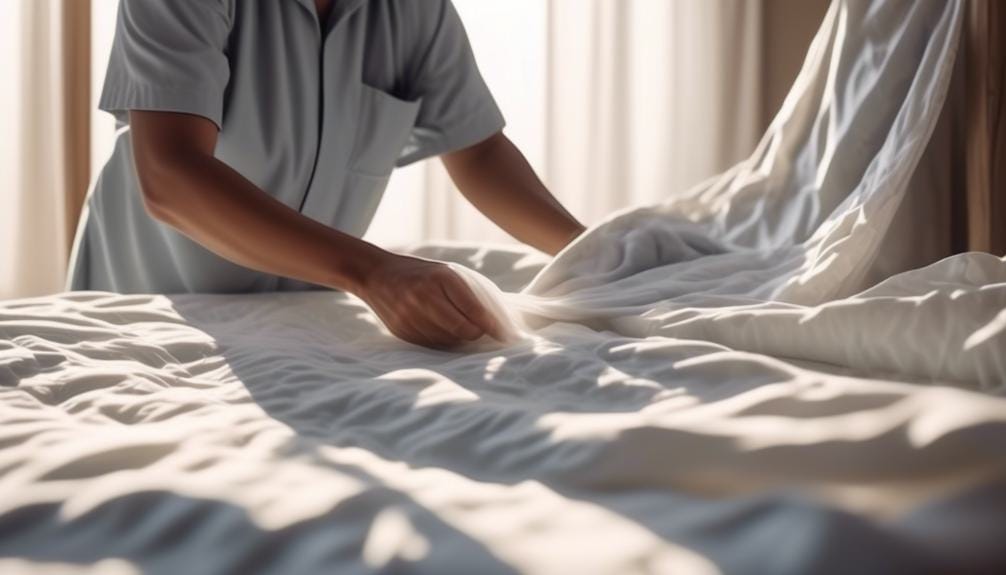
To maintain the quality and cleanliness of your white bedding, it’s essential to adhere to regular maintenance tips to prevent stains and preserve the fabric’s integrity.
- Regular Washing: Wash your sheets once per week or at least once every two weeks to prevent the build-up of stains and grime. This will help to keep your sheets looking fresh and clean.
- Gentle Detergent: Use a gentle detergent specifically formulated for white or delicate fabrics to maintain the quality of the sheets. Harsh detergents can cause yellowing and damage the fabric over time.
- Air Drying: Consider air drying your sheets to maintain their quality and to eliminate any vinegar smell after using whitening methods. This will also help to preserve the fabric’s integrity.
- Prevent Spills: Avoid eating in bed to prevent food stains and spills that can damage the sheets and mattress. Additionally, consider using a mattress protector or breakfast tray to further prevent spills and stains on the sheets.
Frequently Asked Questions
How Do I Get My White Duvet Cover White Again?
To get your white duvet cover white again, add baking soda to the washing machine drum and pour white vinegar into the fabric softener dispenser. Avoid mixing them together. After the first load, expect noticeably whiter and softer covers.
How Do You Get Yellow Out of White Duvet Cover?
To get yellow out of a white duvet cover, mix half a cup of baking soda in the wash, add vinegar to the fabric softener dispenser, or soak the cover in lemon juice and water. Avoid mixing vinegar and baking soda to maintain their whitening effects.
How Do You Lighten a Duvet Cover?
To lighten a duvet cover, mix half a cup of lemon juice or borax with a gallon of hot water, soak overnight, then machine wash. Add baking soda to the drum and vinegar to the fabric softener dispenser.
How Do You Whiten a Dingy White Comforter?
To whiten a dingy white comforter, start by soaking it in a mixture of lemon juice or borax with hot water overnight. Then, machine wash as usual. Add baking soda and vinegar during the wash, keeping them separate to avoid neutralization.
Conclusion
In conclusion, using natural ingredients like baking soda and white vinegar is an easy and effective way to whiten your duvet cover.
By following the simple steps of adding the ingredients to the washing machine, running a cycle, and drying the cover, you can keep it looking bright and clean with minimal effort.
With these maintenance tips, you can ensure that your duvet cover stays white and fresh for a long time.
